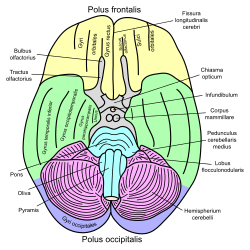Vestibulocerebellar syndrome

Editor-In-Chief: Prab R Tumpati, MD
Obesity, Sleep & Internal medicine
Founder, WikiMD Wellnesspedia &
W8MD medical weight loss NYC and sleep center NYC
| Vestibulocerebellar syndrome | |
|---|---|

| |
| Synonyms | N/A |
| Pronounce | N/A |
| Specialty | N/A |
| Symptoms | Ataxia, dizziness, nystagmus, vertigo |
| Complications | Falls, injury |
| Onset | Varies |
| Duration | Chronic |
| Types | Congenital, acquired |
| Causes | Genetic disorders, stroke, tumors, trauma |
| Risks | Family history, head injury, infections |
| Diagnosis | Clinical examination, MRI, CT scan |
| Differential diagnosis | Multiple sclerosis, inner ear disorders, alcohol intoxication |
| Prevention | N/A |
| Treatment | Physical therapy, medication, surgery |
| Medication | Benzodiazepines, antihistamines |
| Prognosis | Variable, depends on cause |
| Frequency | Rare |
| Deaths | N/A |


Vestibulocerebellar syndrome is a medical condition characterized by a range of symptoms that result from damage or dysfunction of the vestibulocerebellum, a part of the brain that plays a key role in maintaining balance and coordinating eye movements.
Symptoms[edit]
The symptoms of vestibulocerebellar syndrome can vary widely, but often include:
- Dizziness
- Nausea
- Vomiting
- Nystagmus (involuntary eye movement)
- Ataxia (lack of muscle control or coordination)
- Dysarthria (difficulty articulating words)
- Dysmetria (lack of coordination of movement)
Causes[edit]
Vestibulocerebellar syndrome can be caused by a variety of conditions, including:
Diagnosis[edit]
Diagnosis of vestibulocerebellar syndrome typically involves a thorough medical history and physical examination, as well as tests to assess balance, coordination, and eye movements. Imaging tests such as MRI or CT scan may also be used to identify any abnormalities in the brain.
Treatment[edit]
Treatment for vestibulocerebellar syndrome is typically aimed at managing symptoms and treating the underlying cause of the condition. This may involve medication, physical therapy, or in some cases, surgery.
See also[edit]
References[edit]
<references />
Ad. Transform your life with W8MD's Budget GLP-1 injections from $75


W8MD offers a medical weight loss program to lose weight in Philadelphia. Our physician-supervised medical weight loss provides:
- Weight loss injections in NYC (generic and brand names):
- Zepbound / Mounjaro, Wegovy / Ozempic, Saxenda
- Most insurances accepted or discounted self-pay rates. We will obtain insurance prior authorizations if needed.
- Generic GLP1 weight loss injections from $75 for the starting dose.
- Also offer prescription weight loss medications including Phentermine, Qsymia, Diethylpropion, Contrave etc.
NYC weight loss doctor appointmentsNYC weight loss doctor appointments
Start your NYC weight loss journey today at our NYC medical weight loss and Philadelphia medical weight loss clinics.
- Call 718-946-5500 to lose weight in NYC or for medical weight loss in Philadelphia 215-676-2334.
- Tags:NYC medical weight loss, Philadelphia lose weight Zepbound NYC, Budget GLP1 weight loss injections, Wegovy Philadelphia, Wegovy NYC, Philadelphia medical weight loss, Brookly weight loss and Wegovy NYC
|
WikiMD's Wellness Encyclopedia |
| Let Food Be Thy Medicine Medicine Thy Food - Hippocrates |
Medical Disclaimer: WikiMD is not a substitute for professional medical advice. The information on WikiMD is provided as an information resource only, may be incorrect, outdated or misleading, and is not to be used or relied on for any diagnostic or treatment purposes. Please consult your health care provider before making any healthcare decisions or for guidance about a specific medical condition. WikiMD expressly disclaims responsibility, and shall have no liability, for any damages, loss, injury, or liability whatsoever suffered as a result of your reliance on the information contained in this site. By visiting this site you agree to the foregoing terms and conditions, which may from time to time be changed or supplemented by WikiMD. If you do not agree to the foregoing terms and conditions, you should not enter or use this site. See full disclaimer.
Credits:Most images are courtesy of Wikimedia commons, and templates, categories Wikipedia, licensed under CC BY SA or similar.
Translate this page: - East Asian
中文,
日本,
한국어,
South Asian
हिन्दी,
தமிழ்,
తెలుగు,
Urdu,
ಕನ್ನಡ,
Southeast Asian
Indonesian,
Vietnamese,
Thai,
မြန်မာဘာသာ,
বাংলা
European
español,
Deutsch,
français,
Greek,
português do Brasil,
polski,
română,
русский,
Nederlands,
norsk,
svenska,
suomi,
Italian
Middle Eastern & African
عربى,
Turkish,
Persian,
Hebrew,
Afrikaans,
isiZulu,
Kiswahili,
Other
Bulgarian,
Hungarian,
Czech,
Swedish,
മലയാളം,
मराठी,
ਪੰਜਾਬੀ,
ગુજરાતી,
Portuguese,
Ukrainian


